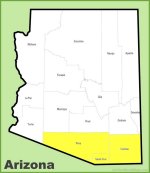
Southern Arizona
“Southern Arizona Search & Rescue and First Responder History: 1901–2000” is a free book written by Butch Farabee. To download it, go to How Can I Download This Book? To learn more about the book, read on.
This book chronicles over 1000 events, some large and involved, such as when two Army Air Servicemen flying between San Diego and Tucson went missing over the remote desert on December 7, 1922. The search for them lasted five months. Or the abduction of little 8-year-old Vicki Lynn Hoskinson on September 17, 1984. The kidnapping of the third-grader was high-profile, her tiny skeletal remains were finally found on April 12, 1985. And sadly, there are even greater tragedies, such as in 1981 when eight people died in a flash flood at Tanque Verde Falls or the mid-air collision over Tucson of two B-24 bombers in 1944, killing all 18 airmen onboard.
Others are not so complex, like the two men forced high into a tree by dangerous floodwaters near the Mexican Border in 1902. Hours later, their wives finally threw them ropes and helped them carefully to shore. Or the two bicyclists overdue in the Rincon Mountains in 1999, they were located by a Department of Public Safety helicopter crew long after dark and then safely walked out by volunteers from the Southern Arizona Rescue Association (SARA). Additionally, we also document Southern Arizona SAR milestones, awards and recognitions, history of organizations, and associated specifics.
Arizona is the sixth largest state in the United States, being about 400 miles long and 310 miles wide. It is bordered on the south by Mexico, on the west by California and Nevada, on the north by Utah, and on the east by New Mexico.
The state has 15 counties, with six of them among the twenty largest in the country. In the book, we identify Southern Arizona as three of the southernmost, namely: Pima, Cochise, and Santa Cruz Counties, but include many incidents in parts of the neighboring counties: Gila, Graham, Greenlee, and Pinal Counties, one incident in Yuma County, and even about a dozen of them in Mexico.
To see a larger version of the map, click on it. Then, to return to this page, use your browser's back arrow.
The accompanying image of Arizona was downloaded from OnTheWorldMap and then shaded to identify Southern Arizona.
“As a newly-minted Tenderfoot Scout, I nearly froze my butt off on my first night ever camping out. But I was hooked that weekend in December 1953. My parents had borrowed a military surplus Kapok Sleeping Bag, maybe good down to 60 degrees. (They weren’t outdoors people.) That crystal-clear, cold night, I could almost see the full moon through its thin covering. While shivering till dawn, I saw the herd of javelina raid our campsite, not once, but twice. I hadn’t ever seen one, since the Desert Museum was to be built the next year. I would not know it for years, but we were in little King Canyon, which is immediately behind the Museum.
“I credit that single experience with Troop 79 and Scoutmaster Jerry Bugglin, for unlocking a whole new world for me. With my seven years in Scouting, I was now off and running, to travel a life of the out-of-doors with all its attendant adventures, good and bad. That Saturday and Sunday, I explored an abandoned mine and ‘discovered’ ancient Indian petroglyphs hidden on the canyon walls. We played Capture-the-Flag on the rugged hillside, and I learned to tie a Square Knot. I gladly ate my cheese sandwich and raw potato. (Did I mention my family was not outdoorsy?)
“At 16 and an Eagle Scout, I went on my first search for the three Boy Scouts lost in the Santa Ritas in November 1958. When the Southern Arizona Rescue Association (SARA) began that same year, I was not part of it although I was in Tucson then. Sixty years later, 2019, after I finished my fifth book, Diving in the National Park Service: An Administrative History, I was looking around for the next project. Three of my first four books dealt with Search and Rescue and it was a big part my world. I asked Anjani Polit, the President of SARA, if they had a written history and if not, I would do one. I wanted to pay homage to their efforts and sacrifices, ‘come rain or come shine.’ ” She said, “no and they’d welcome all the help they could get!”
“Within months, however, I recognized there was both a half-century before SARA and a full century in addition to SARA. So began, Southern Arizona Search and Rescue History: 1901– 2000.”
It contains over 1000 SAR incidents that ocurred in Southern Arizona between 1901 and 2000, and is divided into three parts.
$0.00. We accept cash, checks, or credit cards. Substantial discount for multiple copies. The book comes with a money-back guarantee.
There are two versions of this book, identical in every way, except, one is in color designed to be read online, and the other is in black and white designed to be printed. The color version can be downloaded from here, and the black-and-white version from here. (Of course, you can print the color version, and read the black-and-white online.) Note: Some browsers download silently (that is, in the background). Check your Download folder.
Latest version: 2nd Edition, 2nd Printing. Dated 4/19/2025.